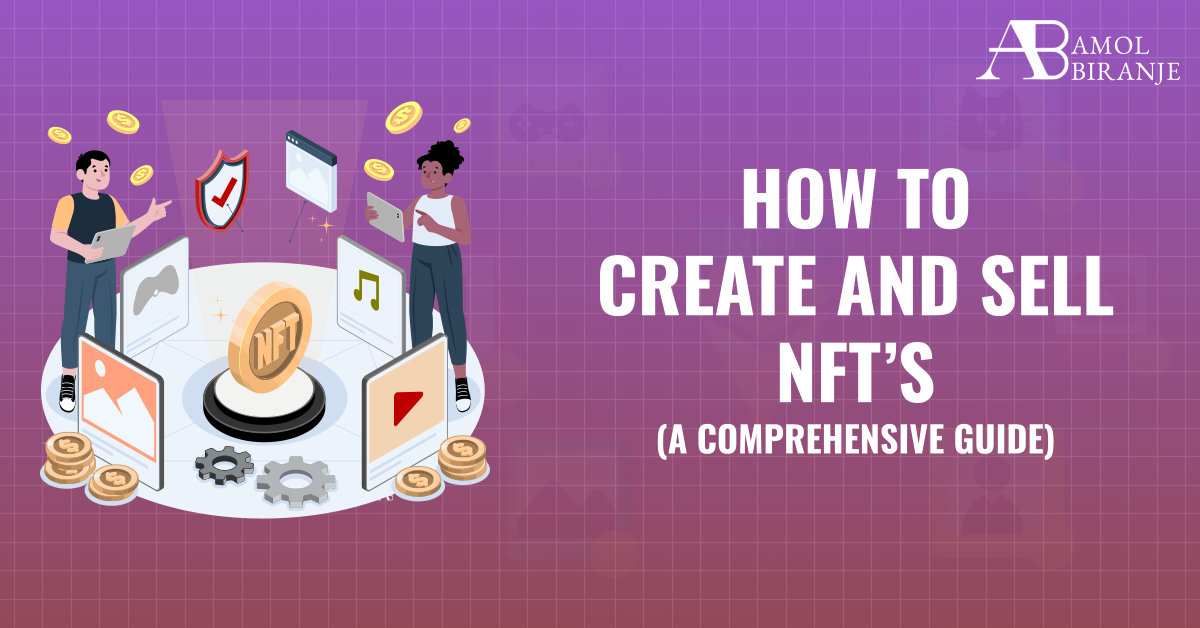Introduction
In the past few years, Non-Fungible Tokens (NFTs) have made an unprecedented impact on the digital realm, completely transforming the methods through which digital assets are bought, sold, and owned. NFTs provide a unique and secure way to represent ownership of digital items, such as artwork, music, videos, virtual real estate, and much more. If you’re interested in exploring the exciting world of NFTs and want to learn how to create and sell them, this How to Create and Sell NFTs comprehensive guide is for you. In this article, I will walk you through the step-by-step process of creating, minting, and selling NFTs like a pro.
Understanding NFTs
What are NFTs?
NFTs are unique cryptographic tokens that represent ownership of a specific digital asset. In contrast to fungible cryptocurrencies like Bitcoin or Ethereum which can be exchanged on a one-to-one basis, Non-Fungible Tokens (NFTs) possess unique properties, rendering them indivisible and truly one-of-a-kind. Every NFT is securely stored on a blockchain, ensuring a transparent and unalterable ledger of ownership.
How do NFTs work?
NFTs use blockchain technology, which ensures that each token has a unique and verifiable identity. Blockchain acts as a decentralized ledger, recording every transaction related to the NFT. This technology guarantees the scarcity, provenance, and authenticity of the digital asset.
Why are NFTs valuable?
The value of an NFT is determined by various factors, including the rarity, demand, and cultural significance of the digital asset it represents. NFTs have gained popularity among collectors, investors, and artists due to their ability to create a direct connection between creators and buyers, as well as the potential for value appreciation over time.
Choosing the Right Platform
Popular NFT marketplaces
There are several NFT marketplaces available, each with its unique features and user base. Some of the most well-known platforms include OpenSea, Rarible, SuperRare, and Foundation. It is essential to research and compare these platforms to find the one that best suits your needs and target audience.
Factors to consider when selecting a platform
When choosing an NFT marketplace, consider factors such as transaction fees, platform popularity, ease of use, community engagement, and the type of digital assets supported. Opting for a platform with a significant user base can increase the visibility and potential sales of your NFTs.
Creating Your Digital Artwork
Tools for digital art creation
To create high-quality digital artwork, you can use various tools and software such as Adobe Photoshop, Procreate, GIMP, or Corel Painter. Experiment with different styles and techniques to develop a unique and captivating piece that resonates with your target audience.
Tips for designing NFT-worthy artwork
Creating artwork that captivates the world of Non-Fungible Tokens (NFTs) requires a blend of creativity, uniqueness, and understanding of the digital art landscape. As you embark on this artistic journey, consider the following tips to craft NFT-worthy artwork that stands out in the ever-expanding NFT market.
Embrace Authenticity and Uniqueness
NFTs thrive on rarity and individuality. To make your artwork NFT-worthy, focus on creating something truly unique and authentic. Avoid replicating existing styles or themes excessively. Instead, let your creativity flow and explore unconventional ideas that set your work apart from the crowd.
Engage Your Audience with Storytelling
Powerful art often tells a compelling story or evokes strong emotions. Leverage storytelling in your NFT artwork to connect with your audience on a deeper level. Whether it’s through symbolism, narrative elements, or thought-provoking concepts, a well-told story can make your NFTs more appealing and memorable.
Experiment with Digital Mediums
The digital realm offers a myriad of tools and mediums for artists to explore. Don’t limit yourself to traditional methods; instead, experiment with digital art forms like generative art, augmented reality (AR), or virtual reality (VR). Pushing the boundaries of what’s possible in the digital space can elevate your NFTs to new heights of creativity.
Pay Attention to Detail and Composition
When creating NFT-worthy artwork, attention to detail and thoughtful composition are essential. Ensure that every element in your piece has a purpose and contributes to the overall aesthetic. Consider factors such as color schemes, balance, and focal points to create visually stunning and harmonious artworks.
Stay on Top of Trends and Themes
The NFT market is ever-evolving, with trends and themes constantly surfacing. Keeping a finger on the pulse of the NFT community and popular culture can help you identify subjects that resonate with potential buyers. However, while trends can inspire, infusing your unique perspective remains critical.
Collaborate and Engage with the Community
The NFT community is vibrant and supportive. Interacting with fellow artists, collectors, and enthusiasts opens doors to precious perspectives and possibilities for creative collaboration. Participate in NFT forums, social media groups, and virtual events to network and learn from others in the NFT space.
Consider the Technical Specifications
To ensure your NFT artwork mints smoothly, consider the technical specifications required by the NFT platform of your choice. Each platform may have specific guidelines for file formats, resolution, and size. Adhering to these specifications can prevent any technical issues during the minting process.
Seek Feedback and Iteration
Feedback from peers and art enthusiasts can be instrumental in refining your NFT artwork. Share your work with others, welcome constructive criticism, and be open to making iterative improvements. Embrace a growth mindset that allows you to evolve as an artist.
Highlight the Rarity of Limited Editions
If you choose to offer limited editions of your NFTs, emphasize their scarcity in your marketing and descriptions. Limited editions can add value to your artwork and incentivize collectors to acquire your NFTs before they become unavailable.
Leverage Social Media and Online Presence
Promoting your NFT artwork requires a robust online presence. Utilize social media platforms, art marketplaces, and personal websites to showcase your portfolio, engage with your audience, and build a dedicated following of art enthusiasts and potential buyers.
Conclusion
In conclusion, we covered How to Create and Sell NFTs. Creating and selling NFTs can be a rewarding venture for artists, collectors, and enthusiasts alike. By understanding the fundamentals of NFTs, choosing the right platform, creating compelling digital artwork, and effectively promoting your NFTs, you can increase your chances of success in this burgeoning market. Embrace the power of blockchain technology, tap into your creativity, and take advantage of the growing interest in NFTs to showcase your talent to the world.
FAQ’s
How to Create and Sell NFTs
Do I need to pay for minting my NFTs?
Yes, minting NFTs involves transaction fees known as “gas fees” on blockchain networks like Ethereum. Gas fees cover the computational resources required to execute smart contracts and record the NFT on the blockchain. The cost of gas fees can vary based on network congestion and the complexity of the smart contract.
What happens to my NFT if the platform where I minted it shuts down?
If the platform where you minted your NFT ceases to exist, the ownership and authenticity of your NFT will remain intact on the underlying blockchain. This is one of the key advantages of using blockchain technology for NFTs. However, you may need to access your NFT through an alternative interface or marketplace if the original platform is no longer operational.
What measures can I take to guarantee the utmost security of my NFTs?
To ensure the security of your NFTs, follow best practices such as using a strong and unique password for your wallet, enabling two-factor authentication, and keeping your private keys offline and secure. Additionally, be cautious of phishing attempts and only interact with trusted platforms and smart contracts.
Can I sell fractionalized NFTs?
Yes, fractionalizing NFTs allows you to divide the ownership of a single NFT into multiple fractions or shares. This enables you to sell smaller portions of high-value NFTs, making them more accessible to a broader audience of investors.
What are the tax implications of selling NFTs?
The tax implications of selling NFTs vary depending on your country of residence and local tax laws. Selling NFTs may be subject to capital gains tax, and it’s essential to keep accurate records of your transactions and consult with a tax professional to understand your tax obligations.
Is it possible to transfer ownership of an NFT to someone else after the initial sale?
This How to Create and Sell NFTs article lets you get ready to make your mark in the digital realm, embrace the power of blockchain, and embark on an extraordinary journey of creativity and expression through NFTs!














0 Comments